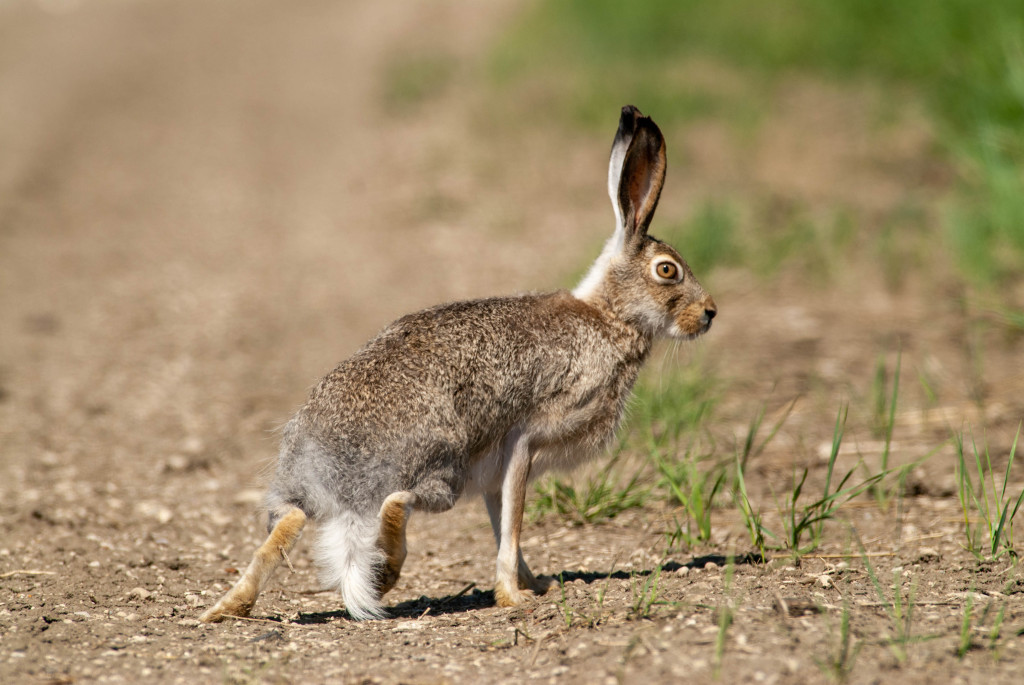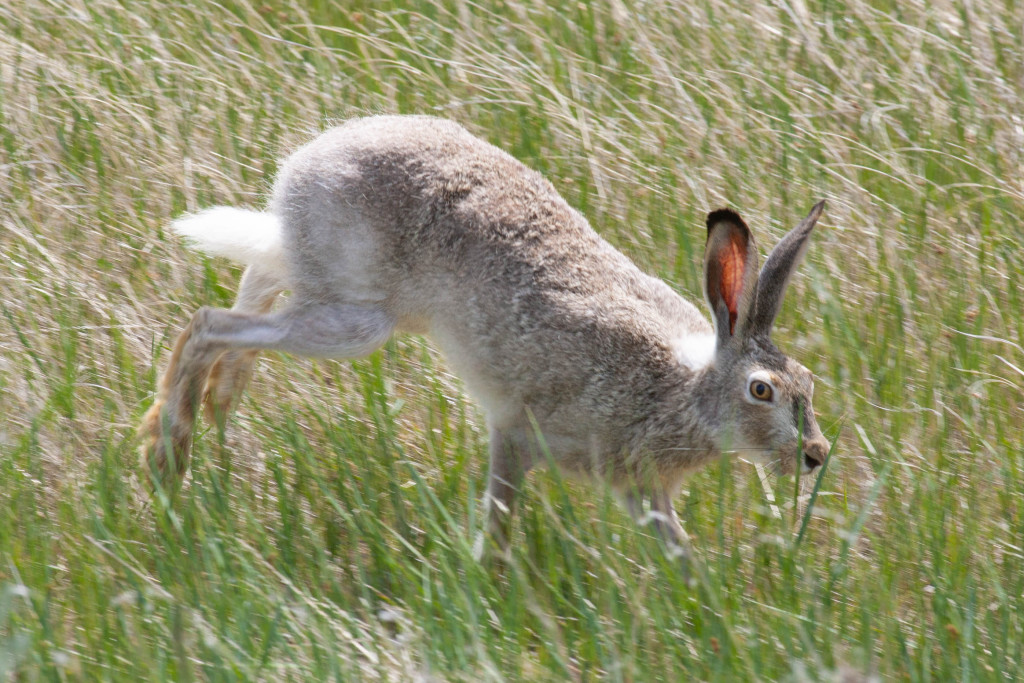This February, we highlight the white-tailed jackrabbit, a Tier II at-risk species in Nebraska.
Enlarge

Photo by Justin Haag
Story by Olivia DaRugna, Watchable Wildlife Biologist
Jackrabbits are always a treat to see. Their awkwardly large ears and eyes and long hind legs give them a cartoonish appearance. Although “rabbit” is in their name, jackrabbits are actually hares, which are precocial, meaning they are born with fur, open eyes and are able to move soon after birth. The white-tailed jackrabbit (Lepus townsendii) is similar in appearance to the black-tailed jackrabbit (Lepus californicus) that also occurs in Nebraska, but as their name suggests, they have a white tail.
The jackrabbit’s range is shrinking across the central plains as prairie habitats are being altered by agriculture and in some areas, overgrazing. Therefore, the white-tailed jackrabbit is a Tier II at-risk species, listed as vulnerable in Nebraska as outlined in the Nebraska Natural Legacy Project.
Predators
White-tailed jackrabbits inhabit sagebrush, open shortgrass prairie and sandhills where they emerge at dusk to forage on grasses, forbs, shrubs, twigs and a variety of other plants. During the day, they hide from predators and rest in shallow depressions at the base of a bush or in a burrow in the snow.
White-tailed jacket rabbits are ideal prey for many prairie predators, including some other at-risk species, such as the golden eagle and swift fox. To evade becoming a meal, jackrabbits have some incredible predator-avoidance adaptations, including their light-brown coloration for camouflage, big eyes and large ears for detecting predators, and strong hind legs for high jumps and quick escapes. When frightened, they stay low to the ground with their ears tucked back and can accelerate to speeds of 40 miles per hour as they zig and zag through the prairie to escape.

Conservation
Jackrabbit populations can be difficult to determine because of their nocturnal nature, cryptic coloration and preference for wide-open grasslands, where there are typically few roads and people. Rural mail carrier surveys are conducted to help track trends in relative abundance, which measures how common or rare a species is relative to other species in a particular area through the years. As the survey name suggests, postal workers record the number of jackrabbits, grouse, turkey and other wildlife species they see along their rural mail routes.
Observation Tips
Although regarded as conspicuous creatures of the open prairie landscape, jackrabbits can be rather difficult to view. They are typically solitary, but beginning in February, their breeding season begins, and they become more active and social. You may see several males competing for the attention of a female by leaping and charging at each other.
To increase your chases of viewing jackrabbits, drive along rural roads at dawn and dusk through prairie habitats in the shortgrass prairie and Sandhill ecoregions. In the shortgrass prairie ecoregion, visit Oglala National Grassland, Agate National Monument and the grasslands near Walgren Lake State Recreation Area. In the Sandhills ecoregion, look for jackrabbits while visiting various wildlife management areas, such as Frye Lake and Smith Lake WMAs.

Use binoculars to scan for a jackrabbit’s large ears sticking out of the grass or near a bush. While exploring in the prairies, you may even see some of the jackrabbit’s predators, like coyotes and hawks. If there is snow on the ground, look for their heads poking out of burrows or for their tracks through untouched snow. They have a galloping stride that may reach 10 feet, and the hind foot may be up to three times longer than the front foot.
Motivate your family to get outside this late winter and early spring by looking for jackrabbits and exploring the western prairies of Nebraska.
If you would like to support conservation efforts of at-risk species, like conserving the prairie habitats the white-tailed jackrabbits and other wildlife rely on, consider donating to the Nebraska Wildlife Conservation Fund.
The post At-risk Species Spotlight: White-tailed Jackrabbit appeared first on Nebraskaland Magazine.
















